AMD Ryzen 9 5980HS Cezanne Review: Ryzen 5000 Mobile Tested
by Dr. Ian Cutress on January 26, 2021 9:00 AM EST- Posted in
- CPUs
- AMD
- Vega
- Ryzen
- Zen 3
- Renoir
- Notebook
- Ryzen 9 5980HS
- Ryzen 5000 Mobile
- Cezanne
CPU Tests: Simulation
Simulation and Science have a lot of overlap in the benchmarking world, however for this distinction we’re separating into two segments mostly based on the utility of the resulting data. The benchmarks that fall under Science have a distinct use for the data they output – in our Simulation section, these act more like synthetics but at some level are still trying to simulate a given environment.
DigiCortex v1.35: link
DigiCortex is a pet project for the visualization of neuron and synapse activity in the brain. The software comes with a variety of benchmark modes, and we take the small benchmark which runs a 32k neuron/1.8B synapse simulation, similar to a small slug.
The results on the output are given as a fraction of whether the system can simulate in real-time, so anything above a value of one is suitable for real-time work. The benchmark offers a 'no firing synapse' mode, which in essence detects DRAM and bus speed, however we take the firing mode which adds CPU work with every firing.
The software originally shipped with a benchmark that recorded the first few cycles and output a result. So while fast multi-threaded processors this made the benchmark last less than a few seconds, slow dual-core processors could be running for almost an hour. There is also the issue of DigiCortex starting with a base neuron/synapse map in ‘off mode’, giving a high result in the first few cycles as none of the nodes are currently active. We found that the performance settles down into a steady state after a while (when the model is actively in use), so we asked the author to allow for a ‘warm-up’ phase and for the benchmark to be the average over a second sample time.
For our test, we give the benchmark 20000 cycles to warm up and then take the data over the next 10000 cycles seconds for the test – on a modern processor this takes 30 seconds and 150 seconds respectively. This is then repeated a minimum of 10 times, with the first three results rejected. Results are shown as a multiple of real-time calculation.
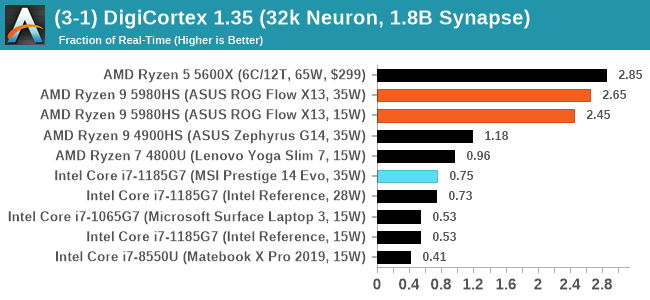
DigiCortex seems to have taken a shine to Zen 3, especially processors with a single chiplet of cores. Intel can't seem to compete here.
Dwarf Fortress 0.44.12: Link
Another long standing request for our benchmark suite has been Dwarf Fortress, a popular management/roguelike indie video game, first launched in 2006 and still being regularly updated today, aiming for a Steam launch sometime in the future.
Emulating the ASCII interfaces of old, this title is a rather complex beast, which can generate environments subject to millennia of rule, famous faces, peasants, and key historical figures and events. The further you get into the game, depending on the size of the world, the slower it becomes as it has to simulate more famous people, more world events, and the natural way that humanoid creatures take over an environment. Like some kind of virus.
For our test we’re using DFMark. DFMark is a benchmark built by vorsgren on the Bay12Forums that gives two different modes built on DFHack: world generation and embark. These tests can be configured, but range anywhere from 3 minutes to several hours. After analyzing the test, we ended up going for three different world generation sizes:
- Small, a 65x65 world with 250 years, 10 civilizations and 4 megabeasts
- Medium, a 127x127 world with 550 years, 10 civilizations and 4 megabeasts
- Large, a 257x257 world with 550 years, 40 civilizations and 10 megabeasts
DFMark outputs the time to run any given test, so this is what we use for the output. We loop the small test for as many times possible in 10 minutes, the medium test for as many times in 30 minutes, and the large test for as many times in an hour.
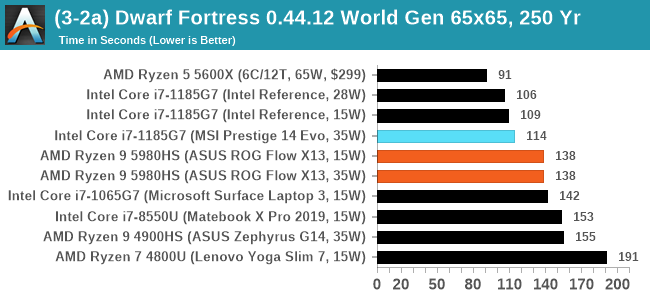
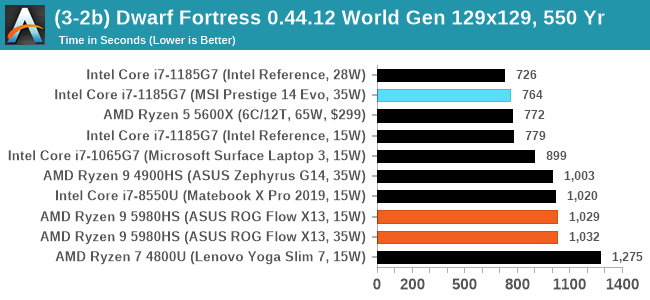
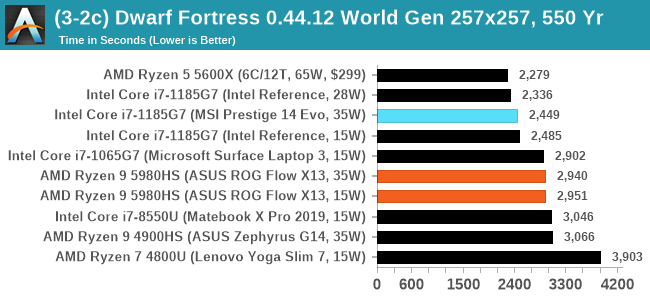
DF has historically been an Intel favorite, and we're not seeing much of a speedup for mobile Zen 3 over mobile Zen 2 here.
Dolphin v5.0 Emulation: Link
Many emulators are often bound by single thread CPU performance, and general reports tended to suggest that Haswell provided a significant boost to emulator performance. This benchmark runs a Wii program that ray traces a complex 3D scene inside the Dolphin Wii emulator. Performance on this benchmark is a good proxy of the speed of Dolphin CPU emulation, which is an intensive single core task using most aspects of a CPU. Results are given in seconds, where the Wii itself scores 1051 seconds.
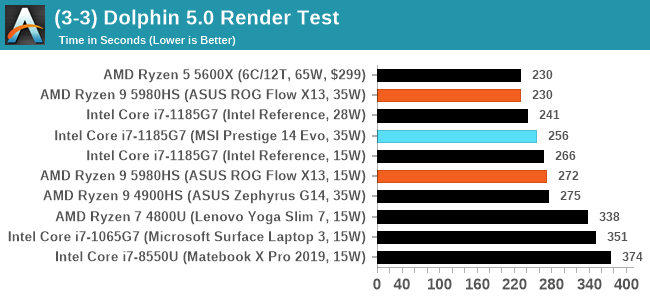
The 35W variant of Cezanne pushes through here, matching the desktop processor, and a sizeable performance jump over the previous generation Renoir.












218 Comments
View All Comments
Zizy - Tuesday, January 26, 2021 - link
I wonder what is the point of new chips with old Zen2. 15% die size difference is meaningful but is that sufficient reason to bother (re)designing? As for the 5980HS, CPU part is pretty great when allowed to run at 35W. "Silent mode" is sometimes great but somewhat weird too - eg CB20MT shows a huge delta between the modes. Now lets just hope AMD/TSMC will manage to actually produce enough of these chips.ToTTenTranz - Tuesday, January 26, 2021 - link
"I wonder what is the point of new chips with old Zen2. "Diversified offer.
Fully operational Renoir is an arguably better performer than a flawed Cezanne with disabled units, and it's cheaper to make.
drothgery - Tuesday, January 26, 2021 - link
But how much cheaper? Zen 3's not that much of a bigger die than Zen 2, and it's fabbed on the same process.SaturnusDK - Wednesday, January 27, 2021 - link
How much cheaper? Until stocks last is my guess.Spunjji - Thursday, January 28, 2021 - link
I'd be interested in whether any of these differences in Lucienne are physical design alterations, as opposed to VRM / BIOS alterations, along with maybe some enabling of silicon that wasn't functional in Renoir for some reason.Either way, Lucienne's probably slightly more than 15% cheaper to make - not sure whether that would make up for the costs of extra masks and design work, though.
Farfolomew - Thursday, February 4, 2021 - link
Ian mentions in the article that he thinks AMD was stockpiling Renoir chips all of last year in order to make a big push with the 5000 series. Is it possible that the stockpiled chips are these Zen2 "Lucienne" variety and once they sell out of them, that's all there will be? I wonder if AMD is having TSMC manufacture new Lucienne chips. I mean, why would you make something that's inferior, if it's on the same exact node as a better product (Cezanne)?e36Jeff - Tuesday, January 26, 2021 - link
saving money. The Zen2 chips offer the power savings that Zen3 got with an already established design. That lets AMD sell them cheaper, and, lets face it, 95% of the end users out there would likely be blown away by a 5700U.On top of that, I would wager the Zen2 chips are a 100% straight drop in upgrade for any existing 4000 series mobile designs, possibly even with little to no BIOS update needed(beyond adding the CPU ID). That lets OEMs show off a Ryzen 5000 laptop with zero extra investment needed.
antonkochubey - Tuesday, January 26, 2021 - link
New chips with old Zen2 aren't really new chips, they're the same silicon and stepping, just running a newer firmware.jospoortvliet - Wednesday, January 27, 2021 - link
Read the review - there are lots of changes besides the cores that supposedly are also in the non-zen 3 5000 chips - given they also get the faster vega this seems true. I do agree it is weird..GeoffreyA - Wednesday, January 27, 2021 - link
From a personal point of view, I don't like this mixing of Zen 2 and 3, not at all, and certainly won't be glad of their continuing this practice; but it does make good sense. In a way, elegant.In this case, it helps to look at the cores as hidden, abstracted, a black box. Now, if such and such model fits its notch on the performance scale (5800U > 5700U > 5600U), then it shouldn't make much difference whether it's Zen 2 or 3 behind the doors. Sort of like an implementation detail.